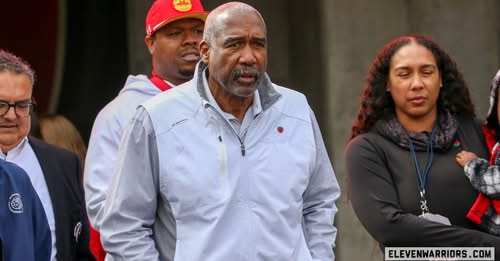Former Ohio State athletic director Gene Smith is reportedly serving as a short-term consultant for Maryland, a development that has caught the attention of the college athletics world and sparked conversations about the role of seasoned leaders in shaping the future of athletic departments. Smith, who retired from his position as Ohio State’s athletic director earlier this year, is widely recognized as one of the most accomplished and influential figures in collegiate sports administration. His decision to take on a consulting role at Maryland comes at a time when the university is actively seeking to refine its athletic strategy and bolster its position in the rapidly evolving landscape of college athletics.
Smith’s reputation precedes him, having spent nearly two decades at Ohio State and overseeing a department that consistently ranked among the best in the nation, both competitively and financially. Under his leadership, Ohio State saw remarkable growth in its athletic programs, with the football team maintaining its powerhouse status, the basketball program consistently competing on a national level, and numerous other sports flourishing under his watch. Beyond wins and championships, Smith was known for his keen business acumen, his ability to navigate complex NCAA regulations, and his forward-thinking approach to the future of collegiate athletics, including NIL (Name, Image, and Likeness) rights, conference realignment, and the financial sustainability of athletic departments.
Maryland’s decision to bring Smith on board, even in a short-term consulting capacity, reflects the school’s desire to draw from his deep well of experience as it charts its future. Maryland has made significant strides since joining the Big Ten Conference in 2014, but it continues to face challenges common to many athletic departments. Balancing the demands of high-profile sports such as football and basketball with the need to support a wide range of Olympic and non-revenue sports requires strategic planning, financial discipline, and a strong vision for growth. Smith’s expertise in these areas is expected to provide valuable guidance as Maryland evaluates its operational structure, revenue strategies, and long-term goals.
For Smith, the consulting role represents a continuation of his career-long commitment to college sports, albeit in a new and perhaps less demanding capacity. While he no longer has the day-to-day responsibilities of managing a major athletic department, his insights remain highly sought after. At Ohio State, he not only managed one of the largest and most successful athletic programs in the country, but he also played a prominent role on the national stage. Smith served on several NCAA committees, including the College Football Playoff Selection Committee, and was a leading voice on issues such as athlete compensation, playoff expansion, and the future of the NCAA governance structure. His ability to build consensus among stakeholders, from university administrators to conference officials to student-athletes, is a hallmark of his career.
Maryland’s athletic department, under the leadership of current athletic director Damon Evans, has made notable progress in recent years. Evans, who took over as athletic director in 2018, has overseen key facility upgrades, coaching hires, and fundraising initiatives aimed at strengthening the department’s competitive edge. However, the landscape of college sports is changing rapidly, and schools like Maryland are under increasing pressure to adapt. The rise of NIL opportunities has transformed the way programs recruit and retain talent, while conference realignment continues to reshape the competitive and financial dynamics of college athletics. By bringing in Smith as a consultant, Maryland is positioning itself to benefit from the knowledge of someone who has successfully navigated these challenges at the highest level.
One of the areas where Smith’s expertise could prove particularly valuable is in revenue generation and financial planning. During his tenure at Ohio State, Smith oversaw a budget that often exceeded $200 million annually, making it one of the most financially robust athletic departments in the nation. He was instrumental in negotiating media rights deals, securing sponsorships, and driving ticket sales and donor contributions. In an era where many athletic departments are struggling to remain financially solvent, Smith’s ability to identify and capitalize on revenue opportunities could provide Maryland with a competitive edge.
Smith’s influence also extends to the realm of athlete welfare and development. He has long been an advocate for providing student-athletes with the resources and support they need to succeed both on and off the field. From academic advising to mental health services to career development programs, Smith emphasized a holistic approach to athlete development during his time at Ohio State. Maryland, which has invested in similar initiatives, could benefit from Smith’s insights on how to enhance these programs and ensure that its athletes are well-prepared for life beyond sports.
The news of Smith’s consulting role has generated considerable interest and speculation among college sports insiders. Some see it as a sign that Maryland is gearing up for a period of significant growth and transformation, while others wonder if Smith’s involvement could lead to more permanent changes in the department’s leadership or strategic direction. While there is no indication that Smith intends to return to a full-time administrative role, his presence alone is likely to carry weight with coaches, staff, donors, and other stakeholders.
It is also worth noting that Smith’s connection to the Big Ten Conference adds another layer of significance to this development. As a longtime athletic director at Ohio State, Smith played a key role in shaping the conference’s policies and priorities. His understanding of the Big Ten’s inner workings, from media negotiations to scheduling to compliance issues, could be particularly beneficial to Maryland as it continues to integrate itself fully into the conference’s ecosystem. The Big Ten’s recent expansion, including the addition of schools like USC, UCLA, Oregon, and Washington, has made the conference even more competitive and financially powerful. Navigating this new landscape requires strategic vision, and Smith’s experience could help Maryland position itself effectively within this evolving framework.
Smith’s career is also notable for his ability to hire and retain top coaching talent. At Ohio State, he was responsible for hiring Urban Meyer, who led the football program to a national championship, as well as Ryan Day, who has continued the program’s tradition of excellence. His track record in identifying and supporting successful coaches extends beyond football, with numerous hires in basketball, baseball, and other sports that contributed to Ohio State’s overall success. Maryland’s ability to compete at the highest levels of the Big Ten will depend in part on its coaching staff, and Smith’s insights into hiring, evaluating, and supporting coaches could be invaluable.
Beyond the immediate impact of his consulting work, Smith’s involvement with Maryland raises broader questions about the role of retired athletic directors in shaping the future of college sports. With decades of experience and a deep understanding of the challenges facing athletic departments, individuals like Smith have much to offer in terms of mentorship, strategic advice, and institutional knowledge. As the pressures on college athletics continue to mount, it is likely that more schools will look to tap into the expertise of retired administrators who can provide guidance without the demands of a full-time role.
For Maryland, the timing of Smith’s involvement is particularly significant. The university has made strides in recent years, but it also faces ongoing challenges, particularly in football, where the program is striving to compete with Big Ten powerhouses like Ohio State, Michigan, and Penn State. Recruiting, player development, and program infrastructure are all areas where Maryland is working to close the gap, and Smith’s insights into what it takes to build and sustain a championship-level program could be instrumental.
Maryland basketball, both men’s and women’s, also stands to benefit from Smith’s consulting role. The men’s program, which has a storied history but has struggled at times in recent years, is looking to reestablish itself as a perennial contender. Meanwhile, the women’s program, which has enjoyed considerable success under coach Brenda Frese, continues to compete at a high level and could gain additional support and resources through Smith’s recommendations. His experience overseeing a wide range of sports at Ohio State gives him a broad perspective on how to allocate resources effectively and build a culture of excellence across an entire athletic department.
In addition to his experience and expertise, Smith brings a reputation for integrity and professionalism that is widely respected throughout the college sports community. His leadership style, which emphasizes collaboration, transparency, and accountability, has earned him the trust of coaches, athletes, and administrators alike. Maryland’s decision to engage Smith as a consultant is likely to be seen as a positive move not only within the university but also among its alumni, fans, and supporters.
The broader implications of Smith’s consulting role also extend to the national stage. As college athletics continues to undergo significant changes, including potential shifts in NCAA governance and the ongoing evolution of NIL policies, the insights of experienced leaders like Smith will be crucial in shaping the future direction of the industry. Maryland’s willingness to seek out and leverage this expertise could position the university as a forward-thinking player in the national conversation about the future of college sports.
From a personal perspective, Smith’s decision to take on this role speaks to his enduring passion for college athletics. Even after stepping away from his role at Ohio State, he remains deeply invested in the success of student-athletes and the institutions that support them. His work with Maryland is likely to be both impactful and closely watched, as other schools consider how they can similarly benefit from the wisdom of retired leaders.



